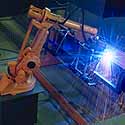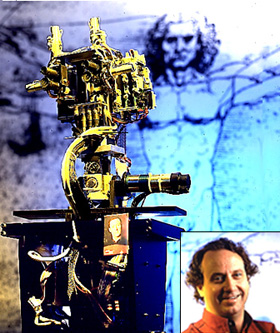

Robots in the present day are not nearly complex enough to imitate humans, other than being able to mimic particular movements and carry out certain very limited functions. Artificial intelligences are, likewise, not much like people yet, although certain programs that were written for the purpose are able to pass themselves off as human, to people who start with the assumption that they are communicating with a human.
Many robots are built for use in industry, and among these are some of the most advanced and least human-looking of their kind. These robots are used to do welding, cutting, packaging, assembly... just about anything that can be done with standardized units can be done by a robot. ABB Robotics Products is a commercial site advertising robots of this type.
 An arc-welding robot from ABB
Robotics
An arc-welding robot from ABB
RoboticsArtificial intelligences are also being developed for use in industry. One such system, in use at Ford, is CAPE, for computer-aided parts estimation. CAPE is what is called an "expert system," with some reasoning ability and a great deal of knowledge in a particular area. Specifically, CAPE is used to estimate the cost of parts for proposed vehicle designs. Its estimates are more accurate than those generated by humans, and it can do in half an hour calculations that would otherwise take two weeks. Another example of an expert system is the Tennessee Offender Management Information System, in use in the Tennessee prison system. TOMIS was created to oversee various aspects of the prison system, including sentencing, release, and probation, which had too many rules to be easily handled by people.
Some robots are capable of work that is somewhat more delicate and has a greater element of customization. One robot of this type is "robodoc," which had its first test on a human patient in November of 1992. This was the first time a robot had performed any part of a surgery on a human being, in this case drilling a hole in a woman's thigh bone so that it could be attached to an artificial hip. This application demonstrates why robots are useful; not only did robodoc succeed in the operation, but it performed its function about four to five times as well as a human surgeon could have. (Conventional methods of performing this surgery result in approximately 20% surface contact between bone and implant, while robodoc produced over 90% contact, meaning that the fit between the two is much tighter and heals better.)
Artificial intelligence is also useful to researchers in medicine and biology. Some molecular biology labs are using an AI system known as Grail to sort through the enormous amounts of data generated by DNA sequencing. Grail is a system that is capable of learning the rules by which one may tell a piece of "junk" DNA from something that will ultimately become part of a protein, or a regulatory sequence. According to its creator, after training Grail has about 90% accuracy when tested on already known DNA sequences. Other AI systems are doing things that are simply not possible for humans, such as predicting the folding patterns of large proteins, and even making guesses as to function. An AI system applied to analyzing the effects of different mutations in a particular protein has discovered some interesting correlations between how deadly a given mutation is and what unmutated amino acids are in certain positions relative to the mutation. Humans don't have the analytical and computational abilities to determine the folded structures of proteins from their amino acid sequences, (AI systems aren't very good at it yet, either.) and would probably not notice patterns as subtle as that detected by the system studying mutation lethality. To learn more about current research and applications for artificial intelligence, check out the AI labs at MIT.
Some research is being done into the possibility of getting groups of autonomous robots to perform tasks cooperatively. These robots function independently of each other, but work together to get things done. For instance, a researcher at Brandeis University has created a "community" of fourteen small robots, who work together to find "pucks" in the lab and return them to a specific location. While this does not seem very impressive, their creator has potential applications in mind, such as the possibility of using robots like hers to collect fragments of cluster bombs (which may still be explosive) or clean up hazardous waste, two jobs that are extremely dangerous and which require that a lot of ground be covered. Having groups of robots do things like this has the obvious advantage that it doesn't endanger humans, but getting the robots to communicate and cooperate is essential to prevent them from getting in each others' way.
Somewhat similar in general concept is the product being marketed by Robodyne Cybernetics. Instead of having several separate robots that work independently, Robodyne uses robotic cube subunits to put together robots that can move around by changing shape, with the different cubes sliding over each other. Apparently this system could have various effectors mounted on it, such as (potentially) cameras and other sensors, weapons, or arms. The advantage of a system like this is that different numbers and sizes of cubes could be assembled to custom-make a robot for any particular function.
At the cutting edge of robotics are researchers at MIT, who are working on a robot that senses the world in a way similar to how humans do. Their project, named Cog, currently is in the early stages of development; as a first step Cog's creators are trying to teach it how to see. This is more complicated than it sounds, because it involves learning the difference between real motion of objects and apparent motion caused by Cog's own movements, as well as learning how to make two eyes focus and work together. Eventually, they hope that Cog will also learn to hear and possibly have a pressure-sensitive skin, and they are working on designing arms that would be more adaptable than most robotic arms, duplicating aspects of human ability. There are no plans to develop legs for Cog, largely because human-style walking is an extremely complicated process and difficult to reproduce.

The possibility of customizable robots which could include weapons systems, or robots that imitate human behavior and abilities, raises some interesting, if obvious, ethical questions about the uses to which robots may be put in the future. Along with the ethical questions come legal questions, which have been pointed out, though not solved, in some detail. For instance, if a robot kills a person, who exactly is responsible for that? The manufacturer, programmer, and owner of the robot all seem like possibilities. But what if the robot is able to modify its own programming... can the robot itself be held liable? (Self-programming robots that are capable of learning and adapting may come on the market in the not-too-distant future; some artificial intelligences without mobility already have this capability.) The first human fatality caused by a robot was mentioned in the article that raised these questions; it "occurred when a machinist... entered a robot's work envelope. Apparently not programmed to take human frailty into account, the robot used its arm to pin the man to a safety pole, killing him with the force." This incident was seen as a simple industrial accident, but as robots become more common and more complex the legal system will have to adapt with the rest of society.
Society has already had to adapt somewhat to accommodate robots. As robots become more useful and less expensive, they are replacing workers in many industries, particularly manufacturing. These replaced workers then have to learn new jobs, or remain unemployed, if they cannot find work somewhere that hasn't switched to automation. Something like this happens every time a new technology comes into widespread use; the automobile resulted in unemployment for many people who made carriages or horseshoes, and big mechanical looms seriously reduced the number of people needed to manufacture cloth. Similar problems may arise soon as artificial intelligence systems become more powerful. Already some companies use expert systems and other types of decision-making software to assist managers; in the future it is possible that these systems will actually replace the human managers.
In general, most robotics and artificial intelligence research seems to be aimed at creating systems that perform human functions, like factory work or data analysis, but not at machines that actually imitate humans in appearance or sociability. Regardless of our collective hopes or obsessions, robots and AI systems are being developed mainly to make money and reduce human labor, both for the people who make them and the people who buy them, so until there is a market for imitation people, we are unlikely to be interacting with androids.
Cowley, Geoffrey. "Introducing Robodoc." Newsweek, Nov 23, 1992. vol 120, pg 86.
Freedman, David. "AI Helps Researchers Find Meaning in Molecules." Science, Aug 13, 1993. vol 261, pp 844-845.
Inayatullah, Sohail; McNally, Phil. "The Rights of Robots: technology, culture and law in the 21st century." Futures, Apr 1988. vol 20, pp 119-136
Peterson, Ivars. "AI at Work: From Prisons to Autos to Space." Science News, Jul 17, 1993. vol 144, pg 33.
Zimmer, Carl. "The Sharebots." Discover, Sept 1995. vol 16, pg 37.